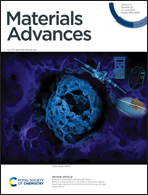Ni(ii) and Zn(ii)-metallogel-based anti-bacterial scaffolds for fabricating light-responsive junction-type semiconducting diodes with non-ohmic conduction mechanism†
Abstract
Metal incorporation into the gelator offers an effective strategy to fabricate soft scaffolds with advanced functionality. Herein, we report self-assembly directed two supramolecular metallogels of sebacic acid with Ni(II) and Zn(II) metal salts. N,N′-dimethyl formamide (DMF) solvent was immobilized within metallogel-scaffolds. Distinct features with diverse morphological patterns as an outcome of versatile supramolecular interactions operating within gel-scaffolds, viz., Ni(II)–sebacic acid (Ni–SB) and Zn(II)–sebacic acid (Zn–SB) were achieved. Both of these metallogels display a visco-elastic nature that was experimentally visualized by means of rheological parameters. To visualize reversible, isothermal, time-dependent sol–gel transitions for both metallogels, thixotropy measurements were performed and the experimental outcome confirmed the thixotropic nature of these reported metallogels. FESEM micro-structural imaging of both metallogels was conducted and revealed dissimilar morphological patterns. Possible non-covalent interactions involved within the metallogel scaffolds were analyzed via FT-IR studies. Both of these metallogels were comparatively studied for their antibacterial activity against human pathogens of Gram-negative and Gram-positive bacteria. Antibacterial activity of both metallogel-scaffolds were tested against Klebsiella pneumoniae (MTCC 109), Vibrio parahaemolyticus, Bacillus cereus (MTCC 1272), and Staphylococcus aureus (MTCC 96). Relative analysis of the antibacterial aspect of both metallogels towards the aforesaid pathogens reveals that Zn–SB may be a better candidate. MIC for Ni–SB was found to be ∼300 μg mL−1 for Gram-positive bacteria, which is approximately 4-fold higher than that of Zn–SB. Apart from the biological significance, these metallogels were utilized for junction-type Schottky-diode device fabrication through sandwich configuration along with the ITO/compound/Al structure. The device fabricated by means of both metallogels exhibits non-ohmic type electrical conduction. The device fabricated by means of Ni–SB exhibits a larger current density under dark conditions than Zn–SB. However, in the presence of light, the device based on Zn–SB shows a higher on/off ratio with respect to Ni–SB.



 Please wait while we load your content...
Please wait while we load your content...